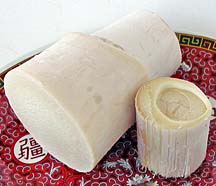
Eleanor Nakama-Mitsunaga
![]()
|
The versatile palm tree and its thousands of varieties produce everything from sugar to oil. One particular delicacy comes from the peach palm, or small palmetto palms that thrive in Florida. The hearts of these palms are prized for their crunchy and delicate flavor.
The basics: Hearts of palm come from the delicate core of a particular variety of palm trees native to Central and South America and introduced to Hawaii in the 1990s. Florida produces the largest commercial crop, which is canned or bottled in brine and sold all over the country.
Although these hearts were originally considered food for the poor, they have blossomed into a gourmet ingredient. To harvest the heart, the entire plant needs to be cut down and stripped, but because the palm grows in clusters, a new shoot is always there to take its place.
The inner, cream-colored stalk resembles a leek with its many layers, or perhaps white asparagus. The flavor has been compared to artichoke or asparagus with a slightly sweet and nutty essence. Hearts of palm are very low in calories and fat and are a good source of fiber.
Selecting: Most hearts of palm come brined in cans or bottles. In Hawaii, though, we have some access to the fresh product from the Wailea Agricultural Group, which has made a new home for the peach palm on the Big Island.
Storing: Hearts of palm stored in brine should be refrigerated after opening and should last several weeks. Fresh hearts of palm are highly perishable and should be used immediately.
Use: Hearts of palm have traditionally been used in salads with a vinaigrette dressing, but chefs nationwide are coming up with a range of new recipes. The heart can be used right out of the can or bottle and sliced. Rinsing may be necessary to remove some of the brine.
Fresh hearts are usually packaged in two pieces: a thin stem piece and a thick base piece. The hard outer layer needs to be removed from the stem, but the base can simply be sliced and served. The hearts can be served raw, made into a dip, sautˇed in lemon juice and butter, added to pasta dishes or as a topping on pizza. Cooking enhances sweetness, but quick cooking or grilling is all that is necessary.
Where to buy: Hearts of palm in brine are available at most supermarkets near other bottled vegetables. Costco will occasionally have large bottles in stock. Fresh hearts can be purchased once a month at the Saturday Farmers' Market at Kapiolani Community College (they will be available this weekend) or at selected Foodland supermarkets. Prices for the canned or bottled variety run $3 to $6 for 14 to 16 ounces. The fresh product sells for $8 a pound from Waialea Agricultural Group.
Eleanor Nakama-Mitsunaga is
a free-lance food writer. Contact her
online through features@starbulletin.com


